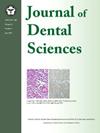Titanium particle-induced inflammasome in human gingival epithelial cells
IF 3.4
3区 医学
Q1 DENTISTRY, ORAL SURGERY & MEDICINE
引用次数: 0
Abstract
Background/purpose
Peri-implantitis remains a substantial challenge. This study investigated the effect of titanium particles on human oral epithelial cells, focusing on the nucleotide-binding domain and leucine-rich repeat protein (NLRP) 3 inflammasome.
Materials and methods
The Ca9-22 human gingival epithelial cell line was subjected to incubation with titanium particles. To evaluate cell viability, the MTT assay was employed. Total RNA was extracted, and messenger RNA (mRNA) expressions of COX2, TGF-β1, NLRP1, NLPR3, CASP1, and AIM2 were analyzed. The concentration of interleukin (IL)1β in cell supernatants was quantified through enzyme-linked immunosorbent assay. Intracellular reactive oxygen species (ROS) were visualized using an ROS assay Kit.
Results
Ca9-22 cells treated with titanium particles showed >75% cell viability across all concentrations tested, with consistent results. mRNA expressions of inflammation-related genes (COX2 and TGF-β1) significantly increased in a dose-dependent manner. The mRNA expression of NLRP3 and CASP1, as well as the secretion of IL1β, increased after 6-h incubation with titanium particles. Moreover, the ROS assay results showed increased production of ROS after treatment with titanium particles, whereas NLRP3 expression and IL1β secretion reduced after treatment with N-acetyl-l-cysteine (ROS scavenger).
Conclusion
Our findings indicate that titanium particles possess a distinct ability to trigger the NLRP3 inflammasome, partly by producing ROS.
钛颗粒诱导的人牙龈上皮细胞炎性体。
背景/目的:种植体周围炎仍然是一个巨大的挑战。本研究调查了钛颗粒对人类口腔上皮细胞的影响,重点是核苷酸结合域和富亮氨酸重复蛋白(NLRP)3炎性体:将 Ca9-22 人牙龈上皮细胞系与钛微粒培养。采用 MTT 法评估细胞活力。提取总 RNA,分析 COX2、TGF-β1、NLRP1、NLPR3、CASP1 和 AIM2 的信使 RNA(mRNA)表达。通过酶联免疫吸附试验对细胞上清液中白细胞介素(IL)1β的浓度进行了定量。使用 ROS 检测试剂盒对细胞内活性氧(ROS)进行检测:用钛颗粒处理的 Ca9-22 细胞在所有测试浓度下的细胞存活率均大于 75%,结果一致。炎症相关基因(COX2 和 TGF-β1)的 mRNA 表达以剂量依赖性方式显著增加。在与钛颗粒培养 6 小时后,NLRP3 和 CASP1 的 mRNA 表达量以及 IL1β 的分泌量均有所增加。此外,ROS 检测结果显示,钛颗粒处理后,ROS 的产生增加,而 N-乙酰-半胱氨酸(ROS 清除剂)处理后,NLRP3 的表达和 IL1β 的分泌减少:我们的研究结果表明,钛颗粒具有触发 NLRP3 炎症体的独特能力,部分原因是产生了 ROS。
本文章由计算机程序翻译,如有差异,请以英文原文为准。
求助全文
约1分钟内获得全文
求助全文
来源期刊

Journal of Dental Sciences
医学-牙科与口腔外科
CiteScore
5.10
自引率
14.30%
发文量
348
审稿时长
6 days
期刊介绍:
he Journal of Dental Sciences (JDS), published quarterly, is the official and open access publication of the Association for Dental Sciences of the Republic of China (ADS-ROC). The precedent journal of the JDS is the Chinese Dental Journal (CDJ) which had already been covered by MEDLINE in 1988. As the CDJ continued to prove its importance in the region, the ADS-ROC decided to move to the international community by publishing an English journal. Hence, the birth of the JDS in 2006. The JDS is indexed in the SCI Expanded since 2008. It is also indexed in Scopus, and EMCare, ScienceDirect, SIIC Data Bases.
The topics covered by the JDS include all fields of basic and clinical dentistry. Some manuscripts focusing on the study of certain endemic diseases such as dental caries and periodontal diseases in particular regions of any country as well as oral pre-cancers, oral cancers, and oral submucous fibrosis related to betel nut chewing habit are also considered for publication. Besides, the JDS also publishes articles about the efficacy of a new treatment modality on oral verrucous hyperplasia or early oral squamous cell carcinoma.
 求助内容:
求助内容: 应助结果提醒方式:
应助结果提醒方式:


